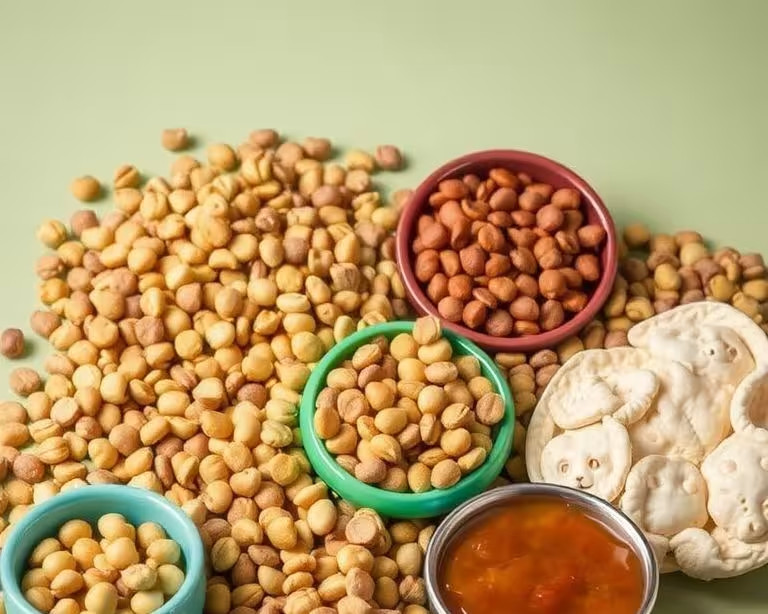Healthy Dog Food for All Life Stages: The Ultimate E-E-A-T Guide

Choosing the right food for your canine companion is arguably one of the most crucial decisions a responsible pet owner makes. It's not merely about filling a bowl; it's about providing a foundation for lifelong health, vitality, and well-being. The concept of 'all life stages' dog food presents an enticing solution for many, promising a single formula that can nourish your dog from their playful puppy days through their energetic adult years and into their golden senior moments. But is it truly a one-size-fits-all miracle, or are there nuances every owner should understand? This comprehensive guide, informed by scientific consensus and data-driven analysis, delves into the intricacies of canine nutrition, helping you navigate the complex world of dog food to ensure your furry friend thrives at every stage of their life.
Decoding Your Dog's Nutritional Needs: A Comprehensive Guide
Optimal canine nutrition is a dynamic science, evolving with each wag of the tail and every passing year. Your dog's dietary requirements are influenced by a multitude of factors, including their age, breed, activity level, and any underlying health conditions. A truly 'healthy' dog food is one that precisely matches these individual needs, preventing nutrient deficiencies or excesses that can lead to health issues.
Understanding the core components of a dog's diet is the first step toward making informed choices. These macronutrients and micronutrients work in synergy to support every bodily function.
Understanding the Building Blocks of Optimal Canine Nutrition
-
Protein: The Foundation of Life
Protein is the cornerstone of a healthy canine diet, providing the essential amino acids necessary for muscle growth, tissue repair, enzyme production, and a robust immune system. High-quality protein sources are paramount. Look for clearly identified animal proteins like chicken, beef, lamb, fish, or eggs listed as the first ingredient. Vague terms like "meat by-products" can be less desirable as they don't specify the source or quality of the protein. -
Fats: Energy, Skin, and Senses
Dietary fats are crucial for concentrated energy, hormone production, absorption of fat-soluble vitamins (A, D, E, K), and maintaining a healthy, shiny coat and supple skin. Essential fatty acids, particularly omega-3 (e.g., from fish oil, flaxseed) and omega-6 (e.g., from chicken fat, vegetable oils), are vital for anti-inflammatory processes and cellular health. Choose foods with healthy fat sources, avoiding overly processed or hydrogenated fats. -
Carbohydrates: Fuel and Fiber
While dogs are carnivores, carbohydrates play a role in providing readily available energy and dietary fiber. Complex carbohydrates from sources like brown rice, oats, barley, sweet potatoes, and peas are preferable to simple sugars or highly refined grains. Fiber is essential for digestive health, promoting regular bowel movements, and supporting a healthy gut microbiome. -
Vitamins and Minerals: The Micronutrient Maestros
These micronutrients are essential for countless bodily functions, from bone formation and nerve transmission to immune response and metabolic processes. While some are naturally present in ingredients, commercial dog foods often fortify their recipes to ensure complete and balanced nutrition according to AAFCO standards. Quality and bioavailability can vary, so a diverse ingredient list often indicates a broader spectrum of naturally occurring nutrients. -
Water: The Forgotten Nutrient
Though often overlooked, fresh, clean water is the most vital nutrient. It facilitates nutrient transport, temperature regulation, lubrication of joints, and waste elimination. Ensure your dog always has access to plenty of fresh water.
Tailoring Nutrition Across Every Life Stage: From Puppy to Senior
A dog's nutritional requirements are not static; they undergo significant shifts as they mature. An "all life stages" food aims to meet these varying demands, but it's important to understand the specific needs of each stage.

Puppy Power: Fueling Rapid Growth and Development
Puppies are bundles of energy undergoing rapid growth and development. They require significantly higher levels of protein and calories compared to adult dogs to support muscle, bone, and organ development. Crucially, they also need a precise balance of calcium and phosphorus for proper skeletal growth. Too much or too little can lead to orthopedic problems, particularly in large breeds. Puppy-specific or "all life stages" formulas designed to meet growth requirements typically feature higher fat and protein content, along with tailored mineral ratios.
Adult Vitality: Maintaining Peak Health
Once a dog reaches adulthood (typically between 1-7 years, depending on breed size), their growth plateaus, and their metabolism stabilizes. Adult dogs need a balanced diet to maintain a healthy weight, support muscle mass, and sustain energy levels without overfeeding. Adult formulas typically provide moderate levels of protein, fat, and calories. The goal here is maintenance, ensuring adequate nutrition for daily activity and cellular repair without promoting excess weight gain.

Senior Wisdom: Supporting Graceful Aging
As dogs age (typically starting around 7-10 years, earlier for large breeds), their metabolism slows, activity often decreases, and they may experience age-related conditions like arthritis, dental issues, or cognitive decline. Senior dog foods often feature lower fat and calorie content to prevent weight gain, along with added joint support ingredients like glucosamine and chondroitin. Some also include antioxidants for immune support and prebiotics/probiotics for digestive health. Protein quality remains crucial to combat muscle wasting, even if total protein percentage is slightly adjusted.
Beyond Life Stages: Breed, Activity, and Individual Needs
While life stage is a primary consideration, other factors profoundly influence dietary choices.
Breed-Specific Dietary Considerations
Certain breeds have unique predispositions that warrant specific nutritional approaches. For instance:
- Large and Giant Breeds: Prone to skeletal issues like hip and elbow dysplasia. Puppy foods for these breeds often have carefully controlled calcium and phosphorus levels to support slow, steady growth, preventing rapid growth spurts that can stress developing joints.
- Small Breeds: Have higher metabolic rates and smaller stomachs, requiring more calorie-dense foods in smaller kibble sizes.
- Brachycephalic Breeds (e.g., Bulldogs, Pugs): May struggle with certain kibble shapes due to their flattened facial structure, requiring specialized kibble designs.
- Breeds Prone to Cardiac Issues (e.g., Boxers, Dobermans): May benefit from foods formulated with specific amino acids like taurine and L-carnitine.
Activity Level: Matching Energy Output with Intake
A couch potato chihuahua and a working Border Collie have vastly different energy requirements. Highly active dogs (e.g., working dogs, agility dogs, those with high daily exercise) need more calories, and often higher protein and fat content, to fuel their energy expenditure and support muscle recovery. Less active or sedentary dogs, on the other hand, require lower-calorie diets to prevent obesity, a significant health concern for many dogs.
Addressing Individual Sensitivities and Health Concerns
-
Allergies and Sensitivities: Food allergies and intolerances are common, with beef, chicken, dairy, and wheat being frequent culprits. Symptoms can range from skin issues (itching, redness) to gastrointestinal upset (vomiting, diarrhea). Identifying and eliminating allergens, often through a veterinary-supervised elimination diet, is crucial.
-
Weight Management: Obesity is epidemic among dogs, leading to conditions like diabetes, joint problems, and heart disease. A weight management plan involves a precisely balanced, often calorie-restricted diet combined with appropriate exercise. Your veterinarian can help develop a safe and effective plan.
-
Sensitive Stomachs: Some dogs are prone to digestive upset. Look for foods marketed for sensitive stomachs, which typically feature easily digestible protein sources (e.g., hydrolyzed proteins), novel proteins (e.g., duck, venison), and often added probiotics and prebiotics to support gut health.
-
Dental Health: Dental disease is one of the most common health problems in adult dogs. While brushing is ideal, certain kibble designs can help mechanically scrape plaque and tartar from teeth. Look for VOHC (Veterinary Oral Health Council) approved foods.
Navigating the Dog Food Aisle: Decoding Labels and Quality Indicators
Dog food labels can be bewildering, filled with jargon and marketing claims. Learning to read them critically is vital.
The A.A.F.C.O. Gold Standard: What it Means for Your Dog
The Association of American Feed Control Officials (AAFCO) establishes nutritional standards for pet foods in the United States. A product bearing an AAFCO statement (e.g., "formulated to meet the nutritional levels established by the AAFCO Dog Food Nutrient Profiles for All Life Stages") indicates that the food provides complete and balanced nutrition for that specific life stage, or for "all life stages." This statement is a critical indicator of nutritional adequacy and is often based on feeding trials or nutrient analysis.
Beyond the Label: Ingredient Quality and Sourcing
-
Guaranteed Analysis: This section lists the minimum percentages of crude protein and crude fat, and maximum percentages of crude fiber and moisture. While useful, it doesn't tell the whole story about ingredient quality or digestibility.
-
Ingredient List: Ingredients are listed in descending order by weight. Look for named meat sources as the first one or two ingredients (e.g., "deboned chicken," "chicken meal," "lamb") rather than ambiguous terms. Avoid artificial colors, flavors, and preservatives whenever possible. Natural preservatives like mixed tocopherols (Vitamin E) are preferable.
-
Whole Foods: A diet rich in identifiable whole foods like whole grains (brown rice, oats), specific vegetables (carrots, peas), and fruits (blueberries) generally indicates higher quality.
Commercial vs. Homemade: A Balanced Perspective
The debate between commercial and homemade dog food often arises. While homemade meals can be appealing, ensuring nutritional balance is exceptionally challenging without expert guidance. A single missing or excessive nutrient can have severe long-term health consequences. If considering homemade, consult with a board-certified veterinary nutritionist to create a balanced, personalized recipe.
Commercial dog foods, when chosen wisely, offer convenience, consistency, and a guarantee of nutritional completeness (if AAFCO compliant). The key is diligent research and selection of high-quality brands that prioritize transparent sourcing and robust nutritional profiles. Don't hesitate to compare different brands, considering factors like ingredient quality, price, palatability for your dog, and your veterinarian's recommendations.
In-Depth Brand Comparison: Top Healthy Dog Foods for All Life Stages
To provide concrete, data-driven insights, let's compare some popular and reputable brands offering "all life stages" or comprehensive life-stage solutions. Please note that exact formulations and prices can vary by region and retailer, but the following provides a representative analysis.

1. Purina Pro Plan Sport All Life Stages Performance 30/20 Formula
- Protein: 30% (min)
- Fat: 20% (min)
- Fiber: 3% (max)
- Typical Price: ~$2.10/lb
- Key Ingredients: Chicken, Brewer's Rice, Corn Gluten Meal, Whole Grain Corn, Animal Fat (preserved with mixed tocopherols)
- AAFCO Statement: Formulated for all life stages, including growth of large size dogs (70 lbs or more as an adult).
- Pros:
- High protein and fat levels are excellent for active, athletic dogs, supporting muscle maintenance and sustained energy.
- Explicitly formulated for all life stages, providing flexibility for multi-dog households or maintaining consistency.
- Widely available and often recommended by veterinarians for performance and overall health.
- Contains live probiotics for digestive and immune health.
- Cons:
- Contains corn and corn gluten meal, which some owners prefer to avoid for dogs with sensitivities or simply choose grain-free options.
- "Animal Fat" is less specific than a named fat source.
- May be too calorie-dense for highly sedentary dogs, potentially leading to weight gain if feeding guidelines aren't strictly followed.
2. Wellness Complete Health All Life Stages Deboned Chicken & Oatmeal Recipe
- Protein: 28% (min)
- Fat: 16% (min)
- Fiber: 4.5% (max)
- Typical Price: ~$3.20/lb
- Key Ingredients: Deboned Chicken, Chicken Meal, Oatmeal, Ground Barley, Peas, Ground Flaxseed, Chicken Fat (preserved with mixed tocopherols)
- AAFCO Statement: Formulated to meet the nutritional levels established by the AAFCO Dog Food Nutrient Profiles for All Life Stages.
- Pros:
- Real deboned chicken is the first ingredient, indicating a high-quality protein source.
- Uses wholesome grains like oatmeal and barley, providing complex carbohydrates and fiber.
- Contains beneficial ingredients like flaxseed for omega fatty acids, and added vitamins and minerals.
- No corn, wheat, or soy, appealing to owners looking for less common allergens.
- Cons:
- Higher price point than many conventional brands.
- While "all life stages," the protein/fat content might be slightly lower than performance-specific formulas for very active dogs, or slightly higher than ideal for very sedentary seniors without careful portion control.
3. Diamond Naturals All Life Stages Chicken & Rice Formula
- Protein: 26% (min)
- Fat: 16% (min)
- Fiber: 2.5% (max)
- Typical Price: ~$1.80/lb
- Key Ingredients: Chicken, Chicken Meal, Whole Grain Brown Rice, Cracked Pearled Barley, Chicken Fat (preserved with mixed tocopherols), Dried Yeast, Dried Beet Pulp
- AAFCO Statement: Formulated to meet the nutritional levels established by the AAFCO Dog Food Nutrient Profiles for All Life Stages.
- Pros:
- More budget-friendly option while still offering a respectable protein and fat content.
- Utilizes whole grain brown rice and barley as complex carbohydrates.
- Enriched with superfoods (e.g., kale, chia seed, pumpkin) and live probiotics to support digestion and overall health.
- Explicit "all life stages" formulation.
- Cons:
- Lower fiber content compared to some other premium options.
- While good, some ingredients might be considered less premium than higher-priced boutique brands (e.g., "chicken fat" vs. specialized fish oil).
- Specific sourcing of ingredients is not always as transparent as some ultra-premium brands.
4. Canidae All Life Stages Multi-Protein Formula
- Protein: 24% (min)
- Fat: 14% (min)
- Fiber: 4% (max)
- Typical Price: ~$2.90/lb
- Key Ingredients: Lamb Meal, Brown Rice, White Rice, Rice Bran, Peas, Chicken Meal, Fish Meal, Safflower Oil
- AAFCO Statement: Formulated to meet the nutritional levels established by the AAFCO Dog Food Nutrient Profiles for All Life Stages.
- Pros:
- Features a multi-protein blend (lamb, chicken, fish) for a diverse amino acid profile, which can be beneficial for overall muscle health.
- Designed specifically to be suitable for all life stages and all breeds, making it convenient for multi-dog households.
- No corn, wheat, or soy.
- Contains HealthPLUS Solutions, a blend of probiotics, antioxidants, and omega fatty acids.
- Cons:
- "Lamb Meal" and "Chicken Meal" are good protein sources but some prefer whole deboned meat as the primary ingredient.
- The protein and fat percentages are slightly lower than performance-oriented "all life stages" formulas, potentially requiring larger portions for highly active dogs.
- Contains multiple grain types, which is fine for most dogs but something to note for specific dietary preferences.
Conclusion: Prioritizing Long-Term Health and Well-Being
Providing your dog with optimal nutrition is not just a responsibility; it's a profound act of love that directly impacts their longevity, vitality, and happiness. While "healthy dog food for all life stages" can offer a convenient and nutritionally complete solution for many dogs, it's critical to understand its implications. These foods are formulated to meet the highest common denominator of nutritional needs, meaning they are adequate for growth and reproduction, and therefore, technically suitable for adult maintenance and senior dogs.
However, an "all life stages" food might be higher in calories and protein than a truly sedentary senior dog needs, potentially contributing to weight gain if portions aren't carefully managed. Conversely, a highly active adult dog might thrive on the robust nutrition offered by an "all life stages" formula. The key is constant vigilance: monitor your dog's weight, coat condition, energy levels, and overall demeanor. These are the most reliable indicators of whether their diet is truly meeting their evolving needs.
Remember to consult your veterinarian before making any significant changes to your dog's diet, especially if they have pre-existing health conditions or if you are considering an "all life stages" food for a very young puppy or a frail senior. Their expert advice, combined with your informed choices, ensures that your furry family member receives the tailored nutrition they need to live a long, healthy, and happy life by your side. Choosing the right food is an ongoing journey, not a one-time decision; stay informed, be observant, and always prioritize your dog's unique well-being.

Frequently Asked Questions About All Life Stages Dog Food
What does "all life stages" mean in dog food?
An "all life stages" designation on dog food means that the product has been formulated to meet the nutritional requirements for growth (puppies), reproduction (pregnant and lactating females), and adult maintenance, as defined by the Association of American Feed Control Officials (AAFCO). This implies it contains sufficient nutrients for the most demanding life stages, making it technically suitable for all.
Is "all life stages" food suitable for puppies?
Yes, by definition, an AAFCO-compliant "all life stages" food is suitable for puppies. It contains the elevated protein, fat, and specific mineral balances (like calcium and phosphorus) necessary for healthy growth and development. However, for large or giant breed puppies, some veterinarians may recommend breed-specific puppy formulas that more precisely control calcium and phosphorus ratios to prevent rapid growth issues.
Is "all life stages" food suitable for senior dogs?
While an "all life stages" food is nutritionally complete for seniors, it may not always be optimal. Senior dogs often have slower metabolisms and reduced activity, meaning they require fewer calories to avoid weight gain. "All life stages" foods tend to be more calorie-dense to support growth and reproduction. If feeding an "all life stages" food to a senior, strict portion control is crucial. Many senior-specific diets also include beneficial ingredients like joint supplements (glucosamine, chondroitin) and antioxidants that may not be present in the same concentrations in an "all life stages" formula.
Are there any downsides to feeding "all life stages" food?
The primary downside is that "all life stages" formulas are designed to meet the highest common denominator of nutritional needs (those of puppies and pregnant/lactating dogs). This means they are often higher in calories, protein, and certain minerals than a moderately active adult or sedentary senior dog might ideally need. This can lead to overfeeding, weight gain, or an imbalance of nutrients in specific circumstances. Careful portion control and monitoring your dog's condition are essential.
How do I transition my dog to a new "all life stages" food?
A gradual transition over 7-10 days is recommended to prevent digestive upset. Start by mixing 25% new food with 75% old food for a few days. Then, move to 50% new and 50% old for a few more days, followed by 75% new and 25% old. Finally, transition to 100% new food. Monitor your dog for any signs of digestive distress like vomiting or diarrhea.
What ingredients should I look for/avoid in "all life stages" food?
Look for: Named animal protein as the first ingredient (e.g., chicken, beef, salmon meal), whole grains (brown rice, oats) or complex carbohydrates (sweet potato, peas), healthy fats (chicken fat, fish oil, flaxseed), added vitamins and chelated minerals, and natural preservatives (mixed tocopherols).
Avoid: Generic "meat meal" or "animal by-products" without specific sources, artificial colors, flavors, or preservatives, excessive fillers (corn, wheat, soy for sensitive dogs), and unnamed fat sources.
How does AAFCO define "all life stages" dog food?
AAFCO defines "all life stages" as a food that meets the nutrient requirements for both growth/reproduction and adult maintenance. This implies the food provides adequate levels of all essential nutrients, including higher energy and protein requirements, as well as specific mineral balances (e.g., calcium and phosphorus) needed for pregnant/lactating dogs and growing puppies. This designation is generally based on either successful feeding trials conducted in accordance with AAFCO protocols or by meeting AAFCO nutrient profiles through laboratory analysis.

 By
By
I wish I had read this guide years ago! My first dog had some unexplained health issues, and looking back, I realize her food wasn't truly matching her needs, especially as she aged. This emphasis on dynamic nutrition and individual requirements really resonates with my past experience and makes me want to do better for my current pup.
Choosing dog food has always been a source of anxiety for me, trying to navigate all the marketing claims. My terrier used to have such dull fur and low energy, but after I started focusing on ingredients aligned with his activity level, his coat is shiny and he's a new dog! This article gives me so much confidence in understanding *why* that change happened.
After reading about the nuances, I'm reconsidering my current 'all life stages' food. Could you recommend any specific formulas that are genuinely good for both a growing puppy and an adult dog, or point me to a resource where I can compare them based on the scientific criteria you outlined?
This article really breaks down the 'all life stages' concept with such depth. I appreciate that it's informed by scientific consensus and data-driven analysis – it makes me trust the advice much more than generic articles out there.
You mentioned the importance of balancing macronutrients and micronutrients. Are there specific brands or product lines that excel at this balance for active large breeds? I'm trying to find one that truly matches the individual needs you talked about.